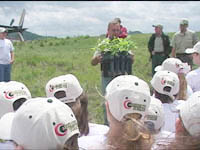Children Re-establish Chestnuts on Bent Mountain
Children Re-establish Chestnuts on Bent Mountain

On a less than ideal spring day, a school bus delivered children to the top of Bent Mountain. These students had two goals in mind on this May Arbor Day – to reclaim land leveled by surface mining and to return an ancient tree to its native environment.
One hundred fifth-graders from Johns Creek Elementary School braved cold temperatures, rain and wind to plant 300 American chestnut trees on the site of Appalachian Fuels’ Bent Mountain mine. The return of the tree to the region, after blight all but erased it from the eastern mountains in the early part of the last century, is a testament to the decades of research and breeding that went into developing a blight-resistant variety.
Don Graves, a professor in the UK forestry department, said the disease took out an extremely valuable tree species. After the blight took its toll, he said, it was assumed that there would never again be American chestnuts in the United States.
“In my time – and you know, they tell me that I’m older than dirt – I haven’t known chestnuts except what were laying on the ground that died,” he said. “This was the big tree of the eastern forests in the days that it was there. It was a very fast growing tree. It was a big tree and it had lots of chestnuts on it. It was good for wildlife. It was very good for wood products. It wouldn’t rot. It was just a superior tree in all ways.”
In a multitude of ways the American chestnut was part of everyday life in the region. The value of the wood lay in its indestructible nature, said Rex Mann, president of the Kentucky Chapter of the American Chestnut Foundation. The first telephone poles and the first railroad ties in the East were made from chestnut, as were rail fences and house shingles.
The nuts themselves, Mann pointed out, were of tremendous value, not only to wildlife but to the populace. People ate them, and earned money from selling them in big cities. Their cattle and hogs also fed heavily off them.
“There was a saying that the chestnut was so much a part of the Appalachian culture that they used it from the cradle to the grave,” Mann said. “When we lost that tree we lost a part of our culture. Now we have the knowledge and the science to restore that tree and that’s a great thing for eastern Kentucky.”
Mann was referring to the careful cross-breeding that has resulted in a new American chestnut that carries the original’s physical characteristics, and the fungus-resistant qualities from both the Chinese chestnut and the few native chestnut trees that survived the blight.
Joining the children in the Arbor Day celebration were representatives from the University of Kentucky forestry department, Appalachian Fuels LLC, Kentucky General Assembly, Kentucky Office of Surface Mines, Department for Natural Resources and Kentucky Chapter of the American Chestnut Foundation.
Graves, who was instrumental in developing the methods used in successful reclamation practices, noted that collaboration between all the agencies is necessary in order to restore the environment to a healthy state.
“This is one of the good things that we’ve got going right now,” he said, “because agencies and industries and universities have not necessarily cooperated with each other in the past and now they are all cooperating and saying, ‘Hey, this is a good thing.’”
The occasion was also a chance to remind the students of the benefit derived from the responsible extraction of coal from the region. Stephen Addington, president of Appalachian Fuels LLC, spoke about the importance of inexpensive, coal-generated electricity, as well as the responsibility he personally feels toward reclamation.
“We have always focused on that and wanted to leave the environment better than what it was before we started the mining,” he said. “We would like certainly, as the Addington family and as our company, to be viewed as ahead of the curve in doing reclamation and getting trees growing back on these mine lands.”
Ultimately, a sudden storm drove the students back inside before they had planted many trees. The task was finished by the adults at the site. But Graves hopes that the young people will have learned that they played an important part in reclaiming Kentucky’s surface mines.
“Surface mines furnish 50 percent of all of the power in the United States and about 80 or 90 percent in the state of Kentucky. This is their lights. This is their computers. This is everything that they deal with on a daily basis and it’s not necessarily bad to do,” he said. “We can put it back in a way that will be suitable for all of the people living there from now on.”
“What a neat thing to put forests back on these reclaimed mine lands after years of not knowing how,” Mann said. “Finally we know how to do that. For the chestnut to be part of that makes me very proud.”
